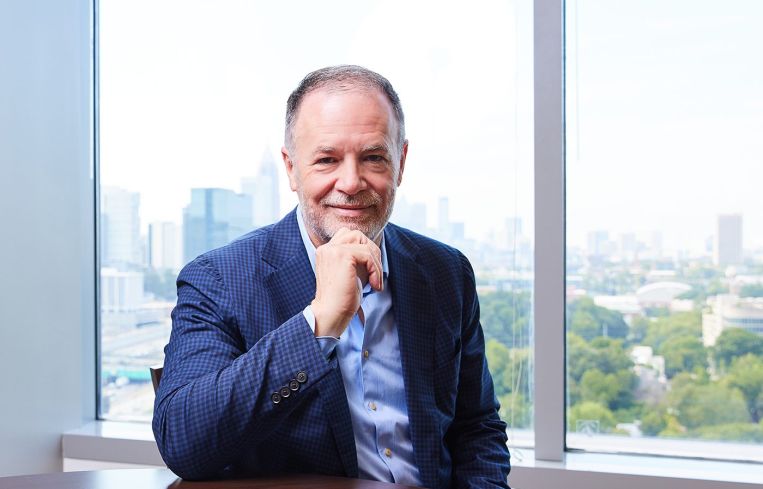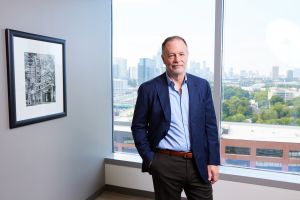All Roads Lead to OZK: Greg Newman on Three Decades of Construction Lending
The Atlanta-based senior managing director remains particularly busy in South Florida
By Cathy Cunningham September 3, 2025 6:00 am
reprints
Unless you’ve been living under a rock in recent years, the name Greg Newman should ring a bell for financing the construction of rock into shiny, impressive buildings on behalf of the industry’s most esteemed owners of real estate. The Bank OZK senior managing director may be based in Atlanta, but his team’s lending reach travels far and wide across the Southeast, and Newman is behind some of the most talked about construction loans in South Florida in particular.
The industry vet, who has more than three decades of experience under his belt, landed at Bank OZK in 2014. While the market has seen plenty of changes since then, the bank’s lending model — low leverage construction loans to top-tier sponsors — has held steady.
As Miami, one of the bank’s core markets, has evolved and grown, OZK has grown with it, leaning into opportunities that fit that model. As such, the bank has established a lengthy track record and become a go-to lender in an ultra-competitive market. Case in point: In June, Newman’s team led the market’s biggest condo construction loan package in South Florida so far this year for Related Ross’ South Flagler House.
Construction lending isn’t for the faint of heart at the best of times, and certainly not at the moment, with tariff uncertainty and interest rate anxiety casting a shadow over some of the strongest development projects. Bank OZK, however, has earned its reputation for certainty of execution and lending through cycles and market dislocation — and isn’t changing now.
Newman chatted with Commercial Observer in late August to fill us in on what he’s lending on today, and why he followed the yellow brick road to OZK more than a decade ago.
This interview has been edited for length and clarity.
Commercial Observer: There’s been no shortage of deals for us to cover this summer. How’s it been for you and the team at OZK?
Greg Newman: It’s been a good and busy summer. I’m fortunate to be in the Southeast, because whether it’s Florida or Georgia or the Carolinas, those markets are doing better than most other markets in the country, and the Southeast office here at Bank OZK is contributing to most of the growth in the RESG [Real Estate Specialties Group] portfolio today.
What’s been your primary lending focus this year?
Our main focus has been condos in Florida, and then multifamily and industrial deals in the Southeast. Those are the deals that seem to make the most sense to us today.
As far as markets go, South Florida is our largest market, so the Miami metro area. It’s our largest book at the bank, and it’s been a really good market for us. We’ve done condo deals, we’ve done office and retail up in West Palm Beach, and we’ve done multifamily down in Miami. Outside of that, we’ve done some deals in Nashville, Tenn., and some industrial deals here in Atlanta. So, we try to spread it out as much as possible.
Tampa has also been a really good market for us.
What do you like about the Tampa market?
The growth it’s having and its affordability. It seems to be more affordable than South Florida, and the climate is just as good. South Florida and Tampa are both hot in the summer, but there’s a different vibe that’s emerging between the two.
We were involved with Water Street Tampa [a $3 billion, 50-acre district comprising retail, offices, homes and hotels], which was a large loan for us at $664 million back in 2019. That project created a center around the Benchmark International Arena and the Downtown Tampa area, and now there’s lots of activity there, with new restaurants that are coming in. I actually believe Tampa could still be in its early stages of growing.
We also did the Gasworx loan this year, a big mixed-use deal just a little bit north of the Channel District in the Ybor City neighborhood market. We think there will be a lot of opportunities to lend in Tampa in the next few years.
Whenever we see a big or exciting construction loan in Miami or South Florida, there’s a good chance OZK is behind it. How have you come to be the go-to lender there, and what’s the competition like today?
Miami is a great market for us, and I think a lot of it has to do with the relationships that we have built over the years. I made my first loan there in 1989, and I’ve been involved in the South Florida market ever since. I’ve been at OZK for 11 years now, and we’ve been a very active player because we know the market so well. The market from when I first started to today has grown tremendously, and, quite frankly, we’ve grown with it. We’ve just taken advantage of the opportunities out there within the growth.
It’s competitive, because there are a lot of local lenders and lenders who are considered out-of-towners. You still have a lot of the New York banks coming in that compete with us, and you also have the debt funds coming in. It all really comes down to what a client wants in terms of leverage. If they want to be more conservative and have lower debt, that’s where we play. But the competitive landscape is undoubtedly there.
We have deep relationships and intensive knowledge of the market, so someone can call on us for a deal, and we’ll know the exact location. Sometimes, we might say, “No, we don’t want to be there.” Or, if it’s a sponsor’s first project we’ll often say no, because we’re not really lending to the first-project guys. We want to lend to the sponsors that are tested, tried and true — the quality sponsors.
What was the 1989 Miami loan that you mentioned?
I made an office loan in Downtown Miami to Tibor Hollo, who passed away last year. The project is now being demolished, and Tibor’s son is going to redevelop it into a whole city block office property with retail on the ground floor.
There are a lot of concerns about rising construction costs as a result of tariffs. Are you changing your approach to lending at all on the heels of the uncertainty?
I don’t think it’s impacting how we lend. Construction costs always rise, and that’s been particularly true since COVID. Prior to COVID, costs were going up, but in small chunks. And, then, after COVID, supply chain issues meant costs shot up. It’s leveled off a little bit, but it’s not coming down. The trend’s not going to change.
Thankfully, our sponsors are pros, and they do a great job of adjusting their projects to account for the higher costs of construction. It’s part of what they do, and I think something that we’re going to have to live with.
There’s a ton of hope out there that the Fed will cut interest rates as we enter the fourth quarter. How much of a difference would decreased rates make to construction activity, do you think?
By its own admission, the Fed’s monetary policy is somewhat tight. They’ve admitted that they’re above target. So we think when the normalization of rates occurs — hopefully, relatively soon, but who knows? — it’s going to be helpful for the economy as a whole, but especially for the construction sector. People have been a bit cautious, waiting to see how tariffs play out. But once all that’s in place and the rates come down, I think there’s going to be a surge in the construction sector.
I’m not an expert on it, but I think that a lot of developers are probably looking for year-end or first-quarter rate cuts, thinking that they might start looking [at some projects] again then.
I’m sure it’s impossible to choose between all your babies, but is there one deal that you’re especially proud of closing this year?
Probably South Flagler House, the [$475 million] Related Ross condo deal we closed up in West Palm Beach. South Flagler House attracted us because we’ve done two other condo deals there. One is next door, Forté, which just got paid off. [OZK provided a $122 million construction loan for the project — owned by Town Roads Development and Alpha Blue Ventures — in 2021.]
And then less than a quarter-mile up the road, we did a deal called Le Clara [for developers Great Gulf and Terrace Mountain Investors]. We’ve had a lot of success in West Palm, and we were drawn to South Flagler House’s quality — and, you can’t get a better sponsor than Related Ross and Stephen Ross. So, we look forward to expanding that relationship.

Generally speaking, what are some of the biggest challenges in construction lending today?
The biggest challenges in construction lending stem from the uncertainty in the economy. A big challenge is the limited partners equity market. The LP equity market is — for lack of a better term — dried up for certain developments.
Now that’s for certain projects, not every one, but it’s extremely difficult today to raise equity for some projects. I think the “haves” are having a hard time and the “have-nots” are having an especially hard time, but this issue is straight across the board and it doesn’t discriminate between South Florida or the Carolinas. I think it’s all across the United States that the LP equity market is looking for better opportunities right now. The hope from these developers is that, with a rate cut or two, they’ll start dipping their toes back into the market and that’ll create more development.
How are people getting around it? Is it a case of taking on more debt, or are some developers pausing for now until the LP market comes back?
Some people are pausing. Others are coming to us, and we might be 50 to 55 percent of cost — in that range — and then they’ll find a mezzanine lender to fill the gap. Some people are just going out and getting a whole loan from a debt fund to take that leverage up to 65 or 75 percent or whatever is needed to execute the project.
Do you have any preference around who’s in the mezz spot when you’re senior lender?
There are some banks that don’t like having secondary lenders on projects, but we’re mezz friendly and we don’t have a preference. We look at the deal based on what we would do, and then the sponsor has to make a decision on which mezz lender they choose. Nine times out of 10, we’ll have done a deal with that lender, though.
Last year, it was reported that OZK would be capping construction loan amounts at $500 million and doing some syndication instead. How has that been going this past year?
It hasn’t really been a big deal for us, because in the history of this company we’ve done four or maybe five deals over $500 million, and that’s it. So, since we established that policy last year, we, truthfully, haven’t had a single transaction that it’s impacted. Five hundred million is a big number, and if I’m at 50 percent of cost, that’s a billion-dollar deal. Those are hard to find.
What was it that initially drew you to Bank OZK?
A really good friend of mine, Rich Smith [now the head of Northeast originations for Bank OZK]. He’d been working here for probably 12, 14 months, and he gave me a call and said that they were looking for somebody to run the Southeast office. Rich and I have been friends for over 28 years and worked at various companies together. That’s how I first got introduced to OZK.
What appealed to you, besides the chance to work with Rich?
That was the main reason: I got to work with Rich again [laughs]. No, it was really the way Rich was describing what OZK was doing and trying to do. I saw the deals that Rich was doing, and that the bank wasn’t doing a whole lot of deals in Florida. So, I saw the opportunity to mirror what Rich was doing, but grow the business here in the Southeast and build a nice book for them. OZK had a handful of deals in Miami, but I had the chance to go down there and reestablish relationships with sponsors and tell them what we had to offer. That was fun. From there, it just grew.
What have some of the biggest changes been at OZK over the past 11 years?
I can tell you this: The lending model hasn’t changed. We’re still focused on low leverage deals with quality sponsors, and that has not changed one bit. But I think where I’ve seen evolution is, the bank’s grown organically by just deposits and doing some loans, and making acquisitions that grew the bank’s footprint. And, so, I think by doing that, we increased our capital base, and when the capital base increased, there was an evolution in increasing our maximum loan size.
When I first started here, to give you an example, $80 million was a very large deal. Since the growth, we look at up to $500 million.
Rewinding further, where did you grow up?
I grew up in a very small town in South Florida called Clewiston. It’s 90 miles north of Miami, in the middle of the state, at the bottom of Lake Okeechobee. So just picture it: a dot in the middle of the state, 60 miles from West Palm Beach and 60 miles from Fort Myers.
Cattle and sugarcane were the industries, and the town was around 5,000 people. My mom worked in the school system, and my dad was an insurance agent.
So how did you get your taste for commercial real estate?
After graduating from Auburn University, I took a job as a credit analyst at a bank in Palm Beach. I’d gotten married, moved back to South Florida, and worked there for about a year. A good friend of mine I grew up with worked for General Electric here in Atlanta in the real estate joint venture group, and there was an opportunity there, so I sent my resume in and I got the job. I moved from West Palm Beach to Atlanta, and I’ve been here ever since. So, that’s how I got my first taste.
As an analyst, I was looking at real estate deals and corporate lines of credit to small mom-and-pop companies and stuff like that. But I really got the bug coming up here, looking at the joint venture side. After about a year, my boss left and went over to Heller Financial, and that’s where I made my first loan, which was that office deal in `89. My first condo deal was in `91 to Ugo Colombo with CMC Group. We’ve financed three deals already for Ugo at OZK, so that’s where the relationships come in.
Was there a time, early in your career, that you knew that this was going to be your career for life?
I was intrigued when I got to the joint venture side, but, then, when I went to Heller, I started in workouts, and I had some deals in Orlando that I had to work out. I think that was the best training ground I had, and I got to understand the pitfalls. So, was it the borrower that created the issue, or is it just a market issue, or was it a timing issue? Once I had that experience, I got the bug, and then once you do your first deal, it’s contagious. That’s when I said, “This is what I’m going to do as my career.”
You were at Fremont Investment and Loan and then iStar around the time of the Global Financial Crisis. How was the GFC for you, and any big lessons learned?
I came to iStar through the acquisition of Fremont, and three months after the acquisition — because we were bought in July of 2007 — was the start of the GFC. So we quickly had to switch from originations to helping work out our loans.
Since I’d done it before, it was relatively easy for me to make that switch, but the biggest thing I learned from the GFC, and looking back at Fremont and some other places, is not to lend at high leverage. I mean, we were lending at 80 percent of cost on deals, and, during the GFC, valuations went down 25 to 40 percent. The beauty of the model here at OZK is we only do low-leverage deals. Our portfolio right now is, on average, 50 percent loan-to-cost, and it’s a model that is proven.
What is OZK’s key competitive advantage in the market today?
We’ve built a really good reputation over the past 22 years in our RESG model, and I think our competitive edge comes down to expertise, because we’re real estate guys in the RESG group, not bankers.
We also stay in the market during tough times, so we offer consistency and certainty of execution. All three are important, but most of the borrowers, developers and sponsors know that if they issue a term sheet, and we get it signed up, we’re going to close.
Cathy Cunningham can be reached at ccunningham@commercialobserver.com.



